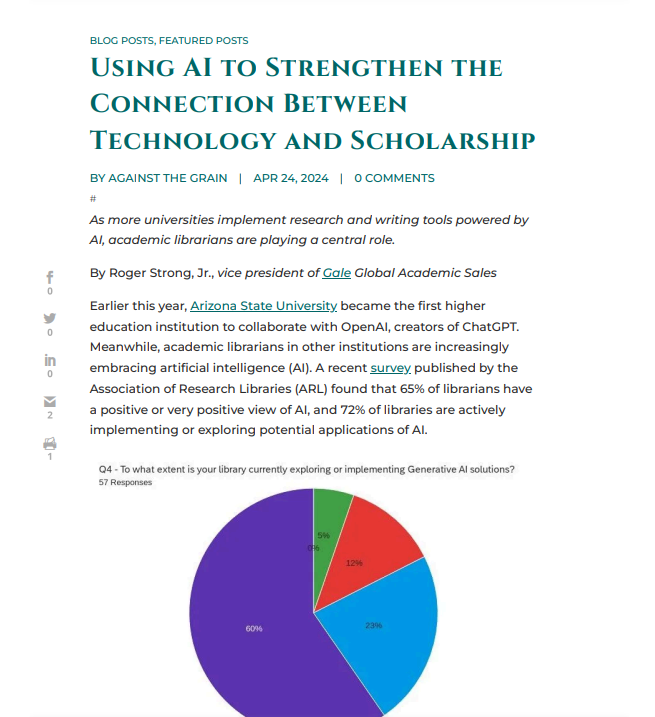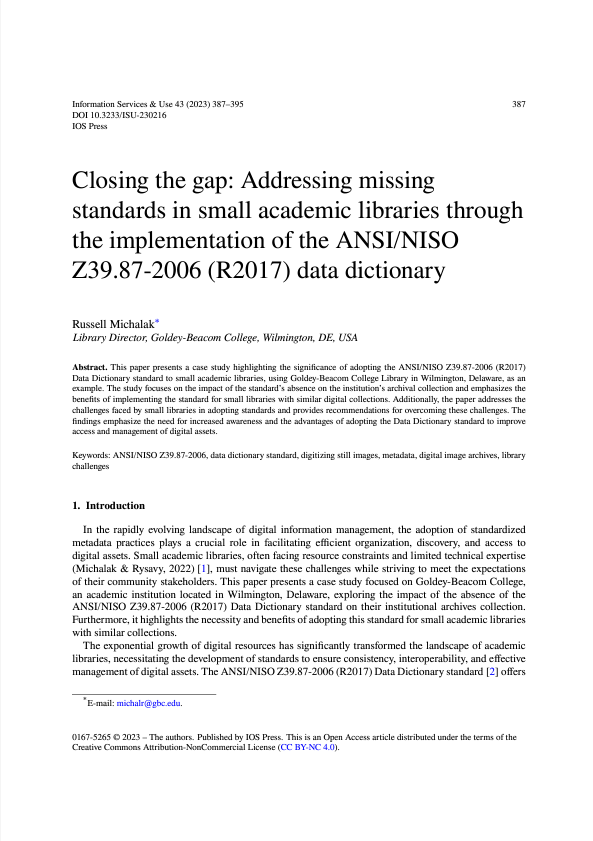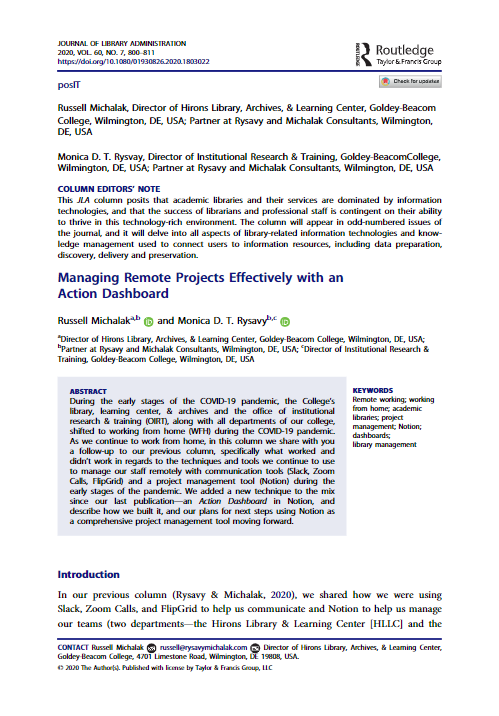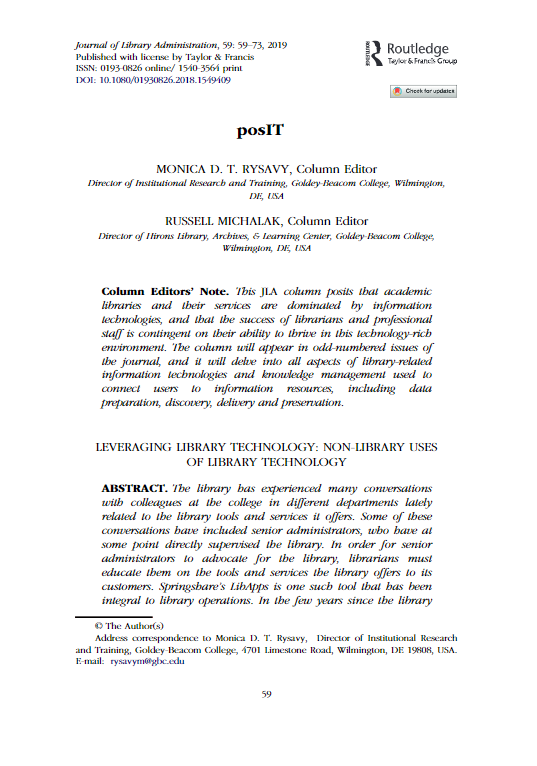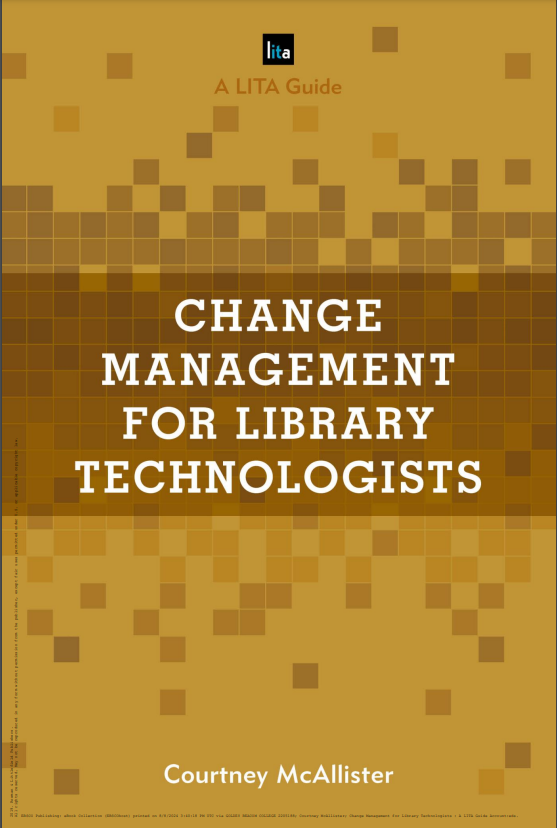Some Publications | Books, Articles, Chapters, & More
Michalak, R., Rysavy, M., Hunt, K., Smith, B. & Worden, J. (2018). Faculty perceptions of plagiarism: Insight for librarians’ information literacy programs. College & Research Libraries, 79(6), 746-767. here
Using a survey modified from The Plagiarism Handbook (Harris, 2001, p. 39), the research team surveyed all undergraduate and graduate faculty (n=79) teaching during the Fall 2016 semester at a small private college in the United States. With a final survey response rate of 59.5% (n=47), the researchers learned that while the faculty's definitions of plagiarism fluctuated, overall faculty definitions paralleled the official definition of plagiarism at this institution. Furthermore, the researchers learned that the vast majority of faculty, 74% (n=35), do not currently invite library staff into their classrooms to teach students how to avoid plagiarism. Given this finding, this study indicates that there was an opportunity for librarians to collaborate with faculty to develop new information literacy and plagiarism deterrent resources. These were intended to support faculty teaching and to additionally market the existing online information literacy training modules, previously developed as part of the authors’ Information Literacy Assessment (ILA) program.
Rysavy, M., Michalak, R., & Hunt, K. (2018). Mapping points of interest: An analysis of
students’ engagement with digital primary sources through digital heat maps and written reflection. American Journal of Distance Education, 32(3), 202-216. here
The Digital Archival Advertisements Survey Process (DAASP) model is a collaborative active learning exercise designed to aid students in evaluating primary source documents of print-based advertisements. By deploying DAASP, the researchers were able to assess the students’ ability to evaluate their biases of the advertisements in a first-year composition course. This research attempts to answer the following research question: Do students perceive heatmap-centered collaboration as helpful with their evaluation of library-licensed digital primary sources? This research explored students’ experiences interacting with and reflecting on archival advertisements (mid-twentieth century) in a first-year composition class in Fall 2017 utilizing the DAASP model.
Rysavy, M., Michalak, R., & Hunt, K. (2018). Information literacy assessment for 1st-year composition students: A case study of three deployment modes. In Handbook of
Research on Learner Experience and Usability in Online Education. IGI. Hershey, PA. here
This chapter describes how the researchers at a small private Master's level college examined how different delivery modes—face-to-face (F2F), hybrid, and online instruction—may impact first-year students' perceptions of their information literacy (IL) skills compared to their test-assessed information literacy skills using the students perception of information literacy-questionnaire (SPIL-Q) and information literacy assessment (ILA) instruments. These instruments were developed and deployed to international graduate business students in two previous studies: Michalak and Rysavy and Michalak, Rysavy, and Wessel. The students (n=161) in this study were enrolled in a first-year English composition course in the Spring 2017 semester. This iteration achieved an overall response rate of 87.04% (n=141). Overall, results demonstrated the greatest achievement were demonstrated by students in hybrid course sections.
Michalak, R. & Rysavy, M. (2018). Online onboarding: Library workplace training in a trilingual interactive online asynchronous environment. Ifenthaler, D. (Ed.) In Digital Workplace Learning - Bridging Formal and Informal Learning with Digital Technologies. New York: Springer. here
The director of the library and learning center (LLC) instituted in 2017 a formal online orientation by requiring all student workers in the library, academic resource center, and office of information technology to take a pretest, watch an online training video, and take a posttest to successfully communicate the departments’ goals, history, and power structure (Bauer. Onboarding new employees: maximizing success. SHRM Foundation’s Effective Practice Guideline Series, 2010). Onboarding student workers, with varied schedules, who are expected to be competent with the job competencies of all job roles in an academic library department can be challenging. This chapter illustrated one academic library’s experiences training two international student workers and one librarian to design online onboarding training modules for student workers. Student workers’ pre- and post-module training are shared, and design plans for future iterations are discussed.
Michalak, R., & Rysavy, M. (2018). Twelve years later: Comparing international business students’ use of physical and electronic library services in 2004 and 2016. Reference Services Review, 46(1), 42-68. here
The purpose of this paper is to use Song’s 2004 survey to assess this institution’s international business students’ perceptions and expectations of library services to improve the quality of services provided.
Rysavy, M., Michalak, R., & Wessel, A. (2017). 8 years of institutional assessment feedback: Students’ satisfaction with library services. Reference Services Review, 45(4), 1- 18. here
The purpose of this paper is to examine eight years of quantitative and qualitative student feedback on library services collected through an institution-wide student satisfaction survey.
Michalak, R., Rysavy, M. & Wessel, A. (2017). Students’ perceptions of their information literacy skills: The confidence gap between male and female international graduate students. The Journal of Academic Librarianship, 43(2), 104-108. here
In the 2015 Summer Session I, the information literacy team combined two instruments, the Information Literacy Assessment (ILA) and the Students' Perceptions of Their Information Literacy Skills Questionnaire (SPIL-Q), into one survey and distributed it to the college's international graduate students through a Google Form. It was distributed to 932 international graduate students, and 172 valid respondents completed the survey. The purpose of this research was to compare the confidence gap in information literacy skills between men and women, particularly in international graduate students. Data collected illustrated that female international business students (n = 70) tended to be slightly more confident than their male counterparts (n = 102) regarding their perceived information literacy skills as evidenced by their SPIL-Q average score across all six IL topics, 3.78, vs. male student's average score of 3.58.
Michalak, R., & Rysavy, M. (2016). Information literacy in 2015: International graduate business students’ perceptions of information literacy skills compared to test-assessed skills. Journal of Business & Finance Librarianship, 21(2), 152-174. here
In 2015, the information literacy (IL) team designed an instrument to determine international graduate business students' perceptions of their IL skills and their actual test-assessed IL skills. The purpose of this research was to compare international graduate students' perceptions of their IL skills versus their test-assessed competencies, with the aim of creating training modules to improve test-identified deficiencies. Results demonstrate that wide discrepancies exist between students' perceptions of their own skills and their actual skills on all six ILA-topic areas assessed by the internally developed test instruments, with students overestimating their abilities in all areas.
Finding Aids. here
These finding aids cover topics about Western Americana, including water in the American West.

